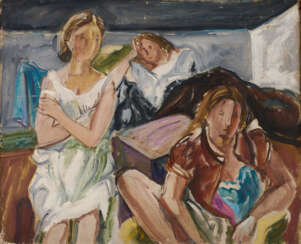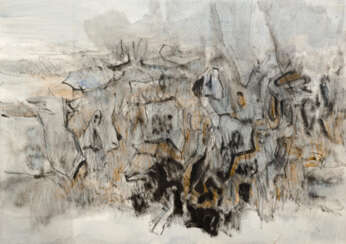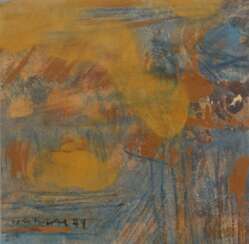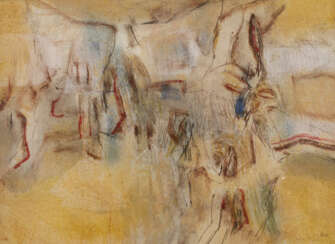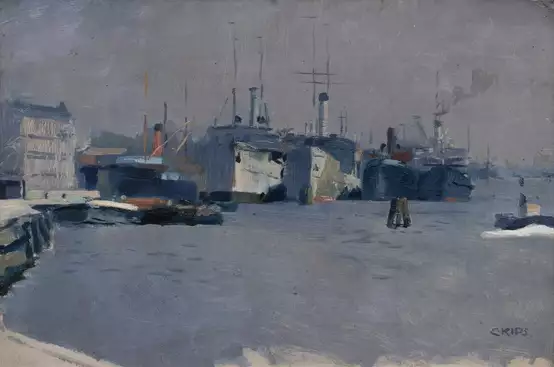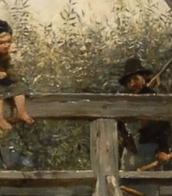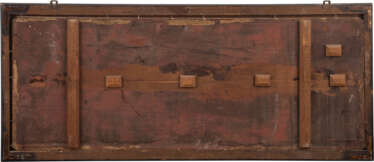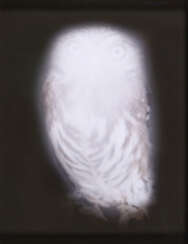conrad westphal

Conrad Westpfahl was a German painter. He was associated with the Expressionist movement in Germany, and his paintings often depicted the landscapes and people of rural Bavaria.
Westpfahl studied at the Academy of Fine Arts in Berlin and later became a professor at the School of Arts and Crafts in Würzburg. He was a member of the Berlin Secession, an association of artists who broke away from the traditional academic art world in the early 20th century.
Westpfahl's style was characterized by bold colors, thick brushstrokes, and a sense of emotional intensity. Later he moved on to more abstract painting.
Today, Westpfahl's paintings are held in collections around the world, including the National Gallery in Berlin and the Museum of Modern Art in New York.


Conrad Westpfahl was a German painter. He was associated with the Expressionist movement in Germany, and his paintings often depicted the landscapes and people of rural Bavaria.
Westpfahl studied at the Academy of Fine Arts in Berlin and later became a professor at the School of Arts and Crafts in Würzburg. He was a member of the Berlin Secession, an association of artists who broke away from the traditional academic art world in the early 20th century.
Westpfahl's style was characterized by bold colors, thick brushstrokes, and a sense of emotional intensity. Later he moved on to more abstract painting.
Today, Westpfahl's paintings are held in collections around the world, including the National Gallery in Berlin and the Museum of Modern Art in New York.


Conrad Westpfahl was a German painter. He was associated with the Expressionist movement in Germany, and his paintings often depicted the landscapes and people of rural Bavaria.
Westpfahl studied at the Academy of Fine Arts in Berlin and later became a professor at the School of Arts and Crafts in Würzburg. He was a member of the Berlin Secession, an association of artists who broke away from the traditional academic art world in the early 20th century.
Westpfahl's style was characterized by bold colors, thick brushstrokes, and a sense of emotional intensity. Later he moved on to more abstract painting.
Today, Westpfahl's paintings are held in collections around the world, including the National Gallery in Berlin and the Museum of Modern Art in New York.


Conrad Felixmüller was a twentieth-century German artist, born Conrad Felix Müller. He is known as a painter, graphic artist, illustrator and printmaker, a representative of the New Materiality movement, who worked in the Expressionist style.
Felixmüller created about 2,500 paintings and graphic drawings, the main motif of which was the human being. The artist considered himself a socially critical expressionist, and his works reflected scenes from everyday life. In the 1930s, many of his works were confiscated by the Nazis as examples of degenerate art and destroyed. As a result of the bombing of Berlin in 1944, Felixmüller lost much of his work.


Conrad Felixmüller was a twentieth-century German artist, born Conrad Felix Müller. He is known as a painter, graphic artist, illustrator and printmaker, a representative of the New Materiality movement, who worked in the Expressionist style.
Felixmüller created about 2,500 paintings and graphic drawings, the main motif of which was the human being. The artist considered himself a socially critical expressionist, and his works reflected scenes from everyday life. In the 1930s, many of his works were confiscated by the Nazis as examples of degenerate art and destroyed. As a result of the bombing of Berlin in 1944, Felixmüller lost much of his work.


Conrad Felixmüller was a twentieth-century German artist, born Conrad Felix Müller. He is known as a painter, graphic artist, illustrator and printmaker, a representative of the New Materiality movement, who worked in the Expressionist style.
Felixmüller created about 2,500 paintings and graphic drawings, the main motif of which was the human being. The artist considered himself a socially critical expressionist, and his works reflected scenes from everyday life. In the 1930s, many of his works were confiscated by the Nazis as examples of degenerate art and destroyed. As a result of the bombing of Berlin in 1944, Felixmüller lost much of his work.


Helmut Sturm was a German painter.
From 1952 to 1958, he studied at the Akademie der Bildenden Künste, Munich. After this he joined Heimrad Prem, Lothar Fischer and Hans-Peter Zimmer in founding Gruppe SPUR, which in 1959 entered the Situationist International.
From 1980 to 1982, he was guest professor at the Hochschule der Künste, Berlin, taking over Hann Trier's class. He continued to exhibit across Germany and from 1985 to 1998 was professor at the Akademie der Bildenden Künste, Munich.


Helmut Sturm was a German painter.
From 1952 to 1958, he studied at the Akademie der Bildenden Künste, Munich. After this he joined Heimrad Prem, Lothar Fischer and Hans-Peter Zimmer in founding Gruppe SPUR, which in 1959 entered the Situationist International.
From 1980 to 1982, he was guest professor at the Hochschule der Künste, Berlin, taking over Hann Trier's class. He continued to exhibit across Germany and from 1985 to 1998 was professor at the Akademie der Bildenden Künste, Munich.



Katharina Grosse is a German artist. As an artist, Grosse's work employs a use of architecture, sculpture and painting. She is known for her large-scale, site-related installations to create immersive visual experiences. She has been using an industrial paint-sprayer to apply prismatic swaths of color to a variety of surfaces since the late 1990s, and often uses bright, unmixed sprayed-on acrylic paints to create both large-scale sculptural elements and smaller wall works.


Anna Vogel is an ultra-modern German photographer who transforms the reality of the natural landscape by creating surreal and abstract photographs using digital and manual elements.


Günther Förg was a German painter, graphic designer, sculptor and photographer. His abstract style was influenced by American abstract painting.



